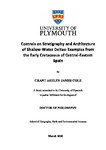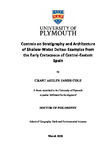Controls on Stratigraphy and Architecture of Shallow-Water Deltas: Examples from the Early Cretaceous of Central-Eastern Spain
| dc.contributor.supervisor | Watkinson, Matthew | |
| dc.contributor.author | Cole, Grant | |
| dc.contributor.other | School of Geography, Earth and Environmental Sciences | en_US |
| dc.date.accessioned | 2020-06-12T13:18:34Z | |
| dc.date.available | 2020-06-12T13:18:34Z | |
| dc.date.issued | 2020 | |
| dc.date.issued | 2020 | |
| dc.identifier | 10285832 | en_US |
| dc.identifier.uri | http://hdl.handle.net/10026.1/15754 | |
| dc.description | At the time of uploading this thesis to PEARL, chapter 4 "Evolution and Process Regime Change from Friction- to Inertia-Dominated of a Shallow-Water Composite Mouth Bar" was accepted with revisions to the journal of Sedimentology and should be published later this year (2020). | en_US |
| dc.description | Full version: Access restricted permanently due to 3rd party copyright restrictions. Restriction set on 12.06.2020 by JM, Doctoral College | |
| dc.description.abstract |
Deltas form where a river meets a standing body of water (e.g. ocean) and deposits its sediment load. They are sensitive recorders of the interplay of fluvial (river) processes, that deliver the sediment to the standing body of water, and wave and tidal processes that redistribute the delivered sediment. When basinal (waves / tides) processes cannot sufficiently redistribute the delivered sediments, river-dominated deltas prevail, which are fantastic recorders of autogenic (internal to the delta) processes that control its overall evolution and internal architecture. Allogenic (external to delta) processes, such as tectonics, can influence and modify the river produced architecture. Therefore, understanding these competing autogenic and allogenic processes is key to creating predictive evolutionary models of river-dominated deltas, and their depositional architecture in the subsurface. This project focuses on a spectacularly well-exposed Early Cretaceous fluvio-deltaic succession of the Maestrazgo Basin in central-eastern Spain. These were deposited in a semiisolated, tectonic rift sub-basin during a rifting cycle from the Upper Jurassic to Middle Cretaceous. The succession displays two regressive phases of shallow-water river-dominated deltas that prograded into a carbonate-dominated shelf during an overall longer term transgression. This project uses a combination of remote sensing and geological fieldwork techniques, and methods of sequence stratigraphy, and architectural element analysis in order to understand the possible autogenic and allogenic processes that controlled the stratigraphy and architecture of the fluvio-deltaic succession. The results show that at the scale of the delta, channel cannibalisation and re-channelisation of the mouth bar top (autogenic process) leads to the creation of mouth bars consisting of multiple smaller-scale sub-bars, which is the first to be reported in ancient river-dominated deltas. At the larger delta depositional scale, the overall evolution displays a combination of eustatic, tectonic, and sediment supply allogenic controls, influencing stacking patterns, internal architecture and overall evolution. This study advances our scientific understanding of these processes but has applied implications for subsurface reservoir architecture models used by the oil and gas industry. | en_US |
| dc.description.sponsorship | 2017: Geologist' Association new researcher award - award of £600 toward PhDs geological fieldwork | en_US |
| dc.description.sponsorship | 2017: AAPG Foundation grants-in-aid - "Horst and Jesse von Bandat Memorial Grant" - award of $1250 towards PhD geological fieldwork | en_US |
| dc.description.sponsorship | 2017: CASP (Cambridge, UK) Geological fieldwork award - award of £1351 towards PhD geological fieldwork | en_US |
| dc.language.iso | en | |
| dc.publisher | University of Plymouth | |
| dc.rights | Attribution-NonCommercial 3.0 United States | * |
| dc.rights.uri | http://creativecommons.org/licenses/by-nc/3.0/us/ | * |
| dc.subject | Delta | en_US |
| dc.subject | Shallow-water | en_US |
| dc.subject | Mixed siliciclastic & carbonate | en_US |
| dc.subject | Shallow marine | en_US |
| dc.subject | Rift basin | en_US |
| dc.subject | Semi-isolated | en_US |
| dc.subject | Sequence stratigraphy | en_US |
| dc.subject | Galve sub-basin | en_US |
| dc.subject | Maestrazgo Basin | en_US |
| dc.subject | Mouth bar processes | en_US |
| dc.subject | Stratigraphic & sedimentary architecture | en_US |
| dc.subject | Lower Cretaceous: Barremian | en_US |
| dc.subject | Virtual Outcrop Model | en_US |
| dc.subject.classification | PhD | en_US |
| dc.title | Controls on Stratigraphy and Architecture of Shallow-Water Deltas: Examples from the Early Cretaceous of Central-Eastern Spain | en_US |
| dc.type | Thesis | |
| plymouth.version | non-publishable | en_US |
| dc.identifier.doi | http://dx.doi.org/10.24382/419 | |
| dc.type.qualification | Doctorate | en_US |
| rioxxterms.funder | Plymouth University | en_US |
| rioxxterms.identifier.project | School of Geography, Earth & Environmental Sciences Studentship | en_US |
| rioxxterms.version | NA | |
| plymouth.orcid.id | 0000-0002-5903-7612 | en_US |
Files in this item
This item appears in the following Collection(s)
-
01 Research Theses Main Collection
Research Theses Main




